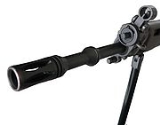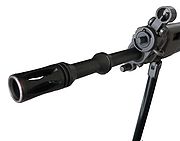
Flash suppressor
Encyclopedia

Rifle
A rifle is a firearm designed to be fired from the shoulder, with a barrel that has a helical groove or pattern of grooves cut into the barrel walls. The raised areas of the rifling are called "lands," which make contact with the projectile , imparting spin around an axis corresponding to the...
or other gun that reduces the visible signature of the burning gases that exit the muzzle. This reduces the chances that the shooter will be blinded in dark conditions. A common misconception is that the flash suppressor is used to hide the shooter's position. This may be incidental, but is not the purpose of the flash suppressor.
Types
Two common types of flash suppressors are the duckbill and birdcage suppressors. Duckbill flash suppressors have upper and lower "prongs" and direct gases to the sides. Early M60 machine gunM60 machine gun
The M60 is a family of American general-purpose machine guns firing 7.62×51mm NATO cartridges from a disintegrating belt of M13 links...
s and some early M16
M16 rifle
The M16 is the United States military designation for the AR-15 rifle adapted for both semi-automatic and full-automatic fire. Colt purchased the rights to the AR-15 from ArmaLite, and currently uses that designation only for semi-automatic versions of the rifle. The M16 fires the 5.56×45mm NATO...
models featured this type of flash suppressor. One disadvantage is that the prongs can become entangled with vines or other natural vegetation and objects in the field. Birdcage types still have prongs, but also feature a ring on the front to prevent vegetation from entanglement between the prongs. Another type of flash suppressor is a flash moderator, such as used on some CAR-15
CAR-15
The Colt Automatic Rifle-15 Military Weapons System or CAR-15 was a family of AR-15 and M16 rifle–based firearms marketed by Colt in the late 1960s and early 1970s. Due to their compact size, the short-barreled Colt Commando and XM177 versions of this family continued to be issued to the U.S...
models. Some examples of cone-shaped hiders are on the Bren
Bren
The Bren, usually called the Bren Gun, was a series of light machine guns adopted by Britain in the 1930s and used in various roles until 1991...
machine gun, the .303 Rifle No 5 Mk 1 "Jungle Carbine
Jungle Carbine
Jungle Carbine was an informal term used for the Rifle No. 5 Mk I which was a derivative of the British Lee Enfield No. 4 Mk I, designed not for jungle fighting but in response to a requirement for a "Shortened, Lightened" version of the No.4 rifle for airborne forces in the European theatre of...
", and some models of the RPK
RPK
The RPK is a 7.62x39mm light machine gun of Soviet design, developed by Mikhail Kalashnikov in the late 1950s, parallel with the AKM assault/battle rifle...
and German MG3.
Reason
Pre-20th century rifleRifle
A rifle is a firearm designed to be fired from the shoulder, with a barrel that has a helical groove or pattern of grooves cut into the barrel walls. The raised areas of the rifling are called "lands," which make contact with the projectile , imparting spin around an axis corresponding to the...
designs tended to have longer barrels than modern rifles. A beneficial side effect of the long barrel is that the propellant is completely burnt before the bullet leaves the barrel, usually resulting only in a puff of smoke from the muzzle. However, if the same weapon is "cut down", as is common in cavalry
Cavalry
Cavalry or horsemen were soldiers or warriors who fought mounted on horseback. Cavalry were historically the third oldest and the most mobile of the combat arms...
and jungle-combat adapted versions, the bullet would often leave the barrel before the powder was completely consumed. In this case, the still burning powder would emit a bright flash from the muzzle.
When barrel lengths were dramatically decreased with the introduction of various short-barrel rifles and carbines, this flash became a serious problem in terms of preserving night vision during combat. Originally limited to "special purpose" roles, it was now expected that all infantry weapons would have short barrels with this problem, and thereby be of limited use in night combat. Flash suppressors became common on late-World War II
World War II
World War II, or the Second World War , was a global conflict lasting from 1939 to 1945, involving most of the world's nations—including all of the great powers—eventually forming two opposing military alliances: the Allies and the Axis...
and later assault rifle
Assault rifle
An assault rifle is a selective fire rifle that uses an intermediate cartridge and a detachable magazine. Assault rifles are the standard infantry weapons in most modern armies...
designs, and are almost universal on these weapons today.
Military flash suppressors are designed to reduce the muzzle flash from the weapon to preserve the shooter's night vision
Night vision
Night vision is the ability to see in low light conditions. Whether by biological or technological means, night vision is made possible by a combination of two approaches: sufficient spectral range, and sufficient intensity range...
, usually by directing the incandescent gases to the sides, away from the line of sight of the shooter, and to reduce the flash visible to the enemy. Military forces engaging in night combat are still visible when firing, especially with night vision gear, and must move quickly after firing to avoid receiving return fire. A comparison video of several flash suppressors, with and without night vision gear, can be found here.
Limiting the amount of powder to what the length of a barrel can burn is one possible solution, but differences between individual cartridges mean that some cartridges will always have too much powder to be completely consumed, and the reduced powder load produces a lower projectile velocity. Muzzle flash can also be controlled by using cartridges with a faster-burning propellant, so that the propellant gases will already have begun to cool by the time they exit the barrel, reducing flash intensities. Faster-burning powders, however, produce less projectile velocity, which reduces the accuracy due to introducing more of a parabolic bullet flight path in place of a "flat" trajectory while also reducing lethality of the weapon through reducing energy delivered on target.
Flash suppressors reduce, or in some cases eliminate, the flash by rapidly cooling the gases as they leave the end of the barrel. Although the overall amount of burning propellant is unchanged, the density and temperature are greatly reduced, as is the brightness of the flash.
A number of different flash hiding designs have been used. The simplest is a cone placed on the end of the barrel, which was used on the late-World War II jungle-combat versions of the Lee-Enfield
Lee-Enfield
The Lee-Enfield bolt-action, magazine-fed, repeating rifle was the main firearm used by the military forces of the British Empire and Commonwealth during the first half of the 20th century...
, the No. 5 variant, intended for use in the Pacific. More modern solutions tend to use a "basket" with several slits or holes cut in it, as seen on the M16
M16 rifle
The M16 is the United States military designation for the AR-15 rifle adapted for both semi-automatic and full-automatic fire. Colt purchased the rights to the AR-15 from ArmaLite, and currently uses that designation only for semi-automatic versions of the rifle. The M16 fires the 5.56×45mm NATO...
and other small-bore weapons. Cone-shaped flash eliminators are also evident on the Bren
Bren
The Bren, usually called the Bren Gun, was a series of light machine guns adopted by Britain in the 1930s and used in various roles until 1991...
LMG and on the turret-mounted aircraft machine guns of British WWII heavy bombers, which were used mostly at night.
Flash suppressors are often used as a muzzle brake
Muzzle brake
Muzzle brakes and recoil compensators are devices that are fitted to the muzzle of a firearm or cannon to redirect propellant gases with the effect of countering both recoil of the gun and unwanted rising of the barrel during rapid fire...
as well by symmetrically
Symmetry
Symmetry generally conveys two primary meanings. The first is an imprecise sense of harmonious or aesthetically pleasing proportionality and balance; such that it reflects beauty or perfection...
cutting slits near the top - but not the bottom - of the hider, which then provides some downward-force on firing as the gases escape upwards, thereby reducing muzzle climb
Muzzle climb
Muzzle climb refers to the elevation of muzzle of automatic and rapid-fire semi-automatic firearms caused by combined recoil from multiple shots being fired in quick succession....
, as well as dust kick-up. This style of muzzle brake
Muzzle brake
Muzzle brakes and recoil compensators are devices that are fitted to the muzzle of a firearm or cannon to redirect propellant gases with the effect of countering both recoil of the gun and unwanted rising of the barrel during rapid fire...
is commonly referred to as a compensator
Compensator
Compensator can refer to:* Pressure control on a piston pump* An alternative term for pipeline expansion joints* A muzzle brake, used to counter the recoil of a firearm, or to prevent the muzzle from climbing due to kickback from the rapid firing of an automatic or semi-automatic weapon* A device...
.
New Zealand
Flash suppressors are seen as a "military" feature, and semi-automatic long guns with suppressors were defined as Military-Style Semi-AutomaticMilitary-Style Semi-Automatic
Military-style semi-automatic is a term in New Zealand firearms law. The category was introduced after the 1990 Aramoana massacre, in which firearms fitting this definition were used....
s in 1992, requiring a permit.
United States
Flash suppressors and barrel shrouds were seen as 'military' features, and were on the list of Federally defined features that could cause a rifle to be defined as illegal, if manufactured after the effective date of the Federal Assault Weapons BanFederal assault weapons ban
The Federal Assault Weapons Ban was a subtitle of the Violent Crime Control and Law Enforcement Act of 1994, a federal law in the United States that included a prohibition on the manufacture for civilian use of certain semi-automatic firearms, so called "assault weapons"...
that went into effect in 1994 in the United States and which expired in 2004. Muzzle brake
Muzzle brake
Muzzle brakes and recoil compensators are devices that are fitted to the muzzle of a firearm or cannon to redirect propellant gases with the effect of countering both recoil of the gun and unwanted rising of the barrel during rapid fire...
s, on the other hand, were ruled "legal" by the ATF
Bureau of Alcohol, Tobacco, Firearms and Explosives
The Bureau of Alcohol, Tobacco, Firearms and Explosives is a federal law enforcement organization within the United States Department of Justice...
. This meant, in practice, muzzle brakes had to be certified by the ATF to prevent end-users from accidentally violating the law and installing a device that could later be found to be defined legally as being more of a flash suppressor than a muzzle brake, even if marketed and sold as a muzzle brake, if incidental flash suppression was deemed to be 'significant' by the ATF. The Federal laws governing this sunsetted in 2004, and are no longer of concern, except in those few jurisdictions in which specific state laws still retain certain provisions of the earlier and now defunct Federal law.

